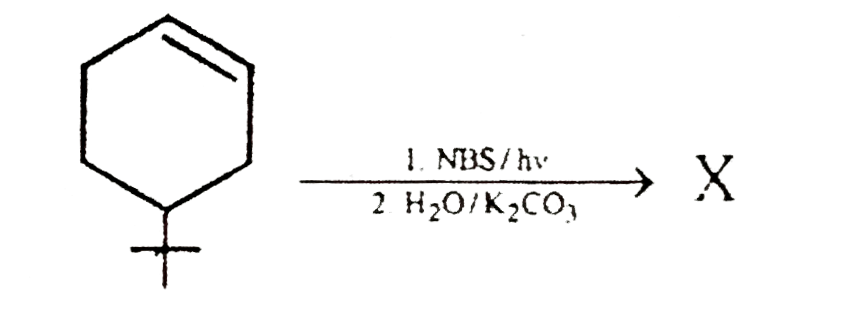Name & give the structural formula for the final organic product formed in each of the reactions given below :
Sodium propanoate & soda lime.
To solve the question regarding the reaction between sodium propanoate and soda lime, we will follow these steps:
Step 1: Identify the Reactants
The reactants in this reaction are sodium propanoate (C2H5COONa) and soda lime. Soda lime is a mixture of sodium hydroxide (NaOH) and calcium oxide (CaO).
Step 2: Understand the Reaction
When sodium propanoate reacts with soda lime, it undergoes a decarboxylation reaction. This means that the carboxyl group (-COOH) is removed from the sodium propanoate, resulting in the formation of an alkane.
Step 3: Write the Reaction
The reaction can be represented as follows:
\( \text{Sodium Propanoate} + \text{Soda Lime} \rightarrow \text{Ethane} + \text{Sodium Carbonate} \)
\( \text{C2H5COONa} + \text{NaOH} \xrightarrow{\text{CaO}} \text{C2H6} + \text{Na2CO3} \)
Step 4: Identify the Products
From the reaction, we can see that the organic product formed is ethane (C2H6), and the inorganic product is sodium carbonate (Na2CO3).
Step 5: Write the Structural Formula
The structural formula for ethane (C2H6) can be represented as:
HH C/HC∣H
Alternatively, it can be written in a more condensed form as CH3-CH3.
Step 6: Name the Product
Since ethane consists of two carbon atoms and is an alkane (no double or triple bonds), the name of the final organic product is ethane.
Final Answer
- Name of the Product: Ethane
- Structural Formula: C2H6 or CH3-CH3
---
The reactants in this reaction are sodium propanoate (C2H5COONa) and soda lime. Soda lime is a mixture of sodium hydroxide (NaOH) and calcium oxide (CaO).
When sodium propanoate reacts with soda lime, it undergoes a decarboxylation reaction. This means that the carboxyl group (-COOH) is removed from the sodium propanoate, resulting in the formation of an alkane.
The reaction can be represented as follows:
\( \text{Sodium Propanoate} + \text{Soda Lime} \rightarrow \text{Ethane} + \text{Sodium Carbonate} \)
\( \text{C2H5COONa} + \text{NaOH} \xrightarrow{\text{CaO}} \text{C2H6} + \text{Na2CO3} \)
From the reaction, we can see that the organic product formed is ethane (C2H6), and the inorganic product is sodium carbonate (Na2CO3).
The structural formula for ethane (C2H6) can be represented as:
HH C/HC∣H
Alternatively, it can be written in a more condensed form as CH3-CH3.
Since ethane consists of two carbon atoms and is an alkane (no double or triple bonds), the name of the final organic product is ethane.
- Name of the Product: Ethane
- Structural Formula: C2H6 or CH3-CH3
Topper's Solved these Questions
- MODEL PAPER -1BOOK - ICSECHAPTER - MODEL PAPER -1EXERCISE - SECTION -II
48 Videos
- METALLURGYBOOK - ICSECHAPTER - METALLURGYEXERCISE - UNIT TEST PAPER 6 - Metallurgy (Select the correct answer from the list A,B,C & given in each statement.)
5 Videos
- MODEL PAPER-2BOOK - ICSECHAPTER - MODEL PAPER-2EXERCISE - SECTION-II
56 Videos
Similar Questions
Name & give the structural formula for the final organic product formed in each of the reactions given below :
1,2, dibromoethane on boiling with alcoholic KOH.
View SolutionName & give the structural formula for the final organic product formed in each of the reactions given below :
Hydration of ethene in presence of conc. H2SO4 at80∘ C.
View SolutionName & give the structural formula for the final organic product formed in each of the reactions given below :
Ethanol vapours and alumina [Al2O3] at 350∘C.
View SolutionName & give the structural formula for the final organic product formed in each of the reactions given below :
Ethanol with acidified K2Cr2O7 on complete oxidation.
View SolutionThe major product formed in the reaction given below will be :

View SolutionThe major product formed in the reaction given below will be:

View SolutionGive the structural formula of each of the Ethanal
View SolutionWrite the structural formula of the main organic product formed when methanal reacts with ammonia.
View SolutionThe product of the reaction gives below is:

View SolutionGive the structural formula of each of the Propanone
View Solution
